We’ve been obsessing over what we wear for thousands of years. Cleopatra loved extravagant evening gowns, Napoleon always dressed to impress, and have you ever seen Shakespeare’s ruffs? They’re truly something to behold.
From signifying status to a means of expression, our love affair with what we wear is no new thing. Nowadays, though, there’s another pressing matter on our minds: the environment. How can we combine an age-old love of clothing with the need to be sustainable? One answer that’s gaining traction at the moment is circularity, and it could be the key to a more eco-friendly industry.

What is Circular Fashion?
“Circularity” has been seeing a lot of attention from the fashion industry over the past few years, though it’s still a bit of a niche topic that hasn’t quite worked its way into the mainstream. But, what does it mean?
The term is actually inspired by “circular economy”, a system that’s designed to create economies that create very little waste. In the world of clothing, it’s a similar concept. Circular fashion is all about extending the lifecycles of what we wear and reducing waste, creating a more sustainable system so that we can preserve our resources, protect the planet, and shop without guilt.
A good way to understand it is by looking at the opposite of circular fashion: the linear approach. This is when a piece of clothing is created, worn (usually for a short amount of time) and thrown away. It’s a direct path from creation to landfill, without much room for movement in the middle. Pretty wasteful, right?
The circular system takes that middle section between creation and landfill and generates more opportunity for the item to remain in the system. In fact, it tries to avoid the clothing ever reaching the landfill at all, which is an idea we can definitely get behind!

How Can Fashion Become Circular?
The beauty of circular fashion is that there are tons of ways it can be put into practice. The first step is to simply create clothes that are made to last and crafted ethically and sustainably.
When the piece of clothing does become worn out, rather than being chucked away, it’s repaired. Sometimes brands will provide materials, like buttons, to make these repairs easier, or the owner of the item may take it to a professional to have it repaired. It’s the old-school method used before fast fashion, and it’s much more conscious of reducing waste.
If the clothing is still in good condition but you don’t want it, circular fashion would encourage you to sell it on, swap it, or donate it to someone else. At this point, the landfill is strictly a no-go zone.
Recycling is a Large Part of Circularity
Another example of circularity is recycling. When a piece of clothing really is at the end of its life, with way too much wear and tear to ever be worn again, it’s recycled. We’re all familiar with the concept of recycling, so this isn’t revolutionary, but it’s a great initiative that’s gaining popularity in the world of fashion.
At the moment, though, recycling clothing isn’t simple – especially garments made from blends of different materials, like polyester and cotton or wool and acrylic. Separating the fibres is a tough task. But, technology is improving, and demand is increasing, which should lead to fabric recycling becoming the norm in the near future.
Why Is Circularity in Fashion So Important?
Fashion is one of the biggest industries in the world. In the UK alone, we spend around £54 billion on clothing and accessories every year, making it one of our countries most lucrative sectors. But all of that comes at a price for the environment.
Around 92 million tonnes of waste comes from the textile industry every year. Without recycling, this leads to one truckload of textiles being dumped into landfills every second; a scale that’s almost impossible to imagine. The rest is burnt, polluting our air and releasing toxic chemicals into the atmosphere.

The simple fact is that we have a problem. The more clothing is churned out, the more waste is produced, and unless something changes, our planet will become swamped in clothes – and not in a good way.
Circularity looks at cutting down that waste and breaking the cycle. By making each piece of clothing last longer, less needs to be produced. The less we produce, the less damage we inflict on the planet in the form of greenhouse gases and water pollution, and – ultimately – the less waste we create.
How Can You Get Involved With Circular Fashion?
The whole idea may sound a bit idyllic right now. Can we really save the world by sewing on a few buttons and selling our old pieces on Depop? In terms of the impact of the fashion industry, yes – and you can start today.
There are so many ways you can start becoming part of the circular fashion industry, including by purchasing clothes made of fabrics that are easier to recycle, like those made from only one sustainable material rather than a blend. Work to make your clothes last longer and, if you know you like a quick turnover in your wardrobe, look into companies that rent out high-quality clothing like One Wear Freedom or buy second-hand. Once you’re finished with clothing, sell it on, donate it, recycle it – whatever keeps it in the system and away from landfill.
If you do buy clothes, focus on finding brands that create sustainable, high-quality fashion that’s made to last. There are so many amazing designers out there embracing the circular system! At Finsu, we’ve made finding these incredible eco-fashion brands easier than ever so that everyone can support circular fashion.
How Finsu Works
We’ve created a website that’s full to the brim with sustainable fashion alongside brands that support the circular system. All you have to do is set your preferences and start uncovering pieces you’d love to wear. It’s a simple method to change the way you shop, helping everyone become a bit more sustainable.
Find out more about how we work, or learn as you go and start browsing through our collections.
